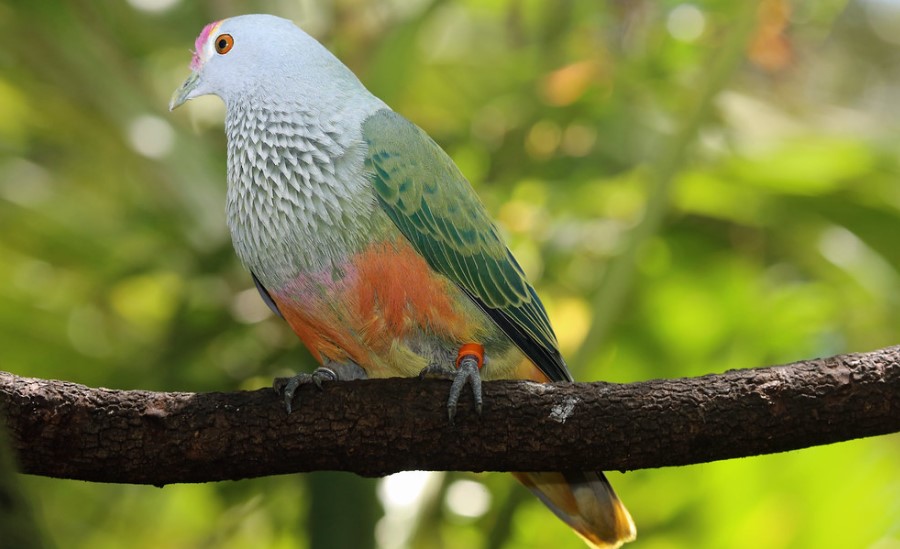Habitat: There is a little dove called the rose-crowned fruit dove that is often overlooked. Despite its bright colors, it blends well with the foliage in which it lives, making it very difficult to notice unless it moves. It lives within dense rainforests in its southern range, often with a substantial understory. Although they are more likely to visit fruit-bearing trees near the top of tall trees,
The species ranges across a broader range of habitats in the north. In areas with fruit-bearing trees, where there are a lot of deciduous vine thickets, mangroves, and paperbark forests, the rose-crowned fruit dove can often be found. It is common to see rose-crowned fruit doves flying about, just above the trees, in open country.
Rainforests, on the other hand, are a land of darting from tree to tree, rarely leaving the shade of a tree. You can best observe the birds by waiting under a tree where you can hear them feeding. The birds usually live in pairs or small groups of five or six, but sometimes they form large feeding flocks.
There is less feeding among epiphytes, vines, and small shrubs among the Rose-crowned Fruit-Dove than among the Superb Fruit-Dove. It spends more time in large trees and palms. Rose-crowned fruit doves move around the forest as fruits ripen, moving from place to place. The distances that individual birds travel are also unknown, but they make long journeys.
There is a sudden rush of birds in the rainforest of northeastern New South Wales in September, but they disappear in April and May, although an occasional bird remains throughout the winter. Further north, the situation is reversed: some birds are present all year, but their numbers increase dramatically between June and September.

Diet: The rose-crowned fruit dove is one of the many fruit pigeons that live in trees. Almost 88 percent of the food they consume in northern Queensland comes from laurels and basswoods. They also consume the fruits of scaly ash trees, tropical quandong trees, Bangalow palm trees, fig trees, and mistletoe trees.
Courtship Displays: As with other members of the genus Ptilinopus, Rose-crowned Fruit-Doves perform courtship bows, advertisement coos, and precopulatory jumps from left to right on branches during courtship.
Male: There is a yellow fringe on the crown of the male bird, which is deep magenta to light magenta. The overall plumage is dull green above; the neck is gray with a green tint; the tip of the tail is yellow; the wing covers are bright green, fringed with yellow; and the primaries are black. Gray and green marks are present on the throat and breasts. There are magenta spots on the lower breast, orange or yellow spots on the belly and undertail, and green spots on the thighs. The eyes are orange-yellow. Dark green is the color of the bill. The feet are grey-green, and the claws are darker.
Females are generally duller than males, especially on the underside.
Immatures: The crown is green; the upper parts are green barred with yellow; the underparts are green scalloped and yellow-washed; and the wings are the same as in adults. Brown is the color of their eyes.
Downy Young: White in color
Voice: It is surprising how loud the rose-crowned fruit dove’s call is. A deep, resonant coo is uttered at first slowly, then fastens and becomes shorter and shorter as it progresses. In addition to a soft and explosive two-syllable coo, there is also a soft and explosive one-syllable coo.
Nesting and Breeding: During the northern wet season, this bird breeds between November and April. Approximately 60 mm in diameter, the nest was made of flimsy material. Usually 3-6 meters above ground, but sometimes up to 30 meters if the nest is above ground in a vine tangle or branch tangle in which thin, loosely interwoven sticks are placed on a horizontal fork. It is common for nests of the eastern race to be found in dense rainforests. In contrast, those of the northern race are usually found in mangroves or paperbark trees in swamps.
Egg: The rose-crowned fruit dove lays one smooth, glossy white egg. A typical egg measures about 30 x 21 mm and is ellipsoidal in shape. Both sexes go through an incubation period of about 17 days. The young fledge between 11 and 12 days after hatching.
Distribution: From Derby to the McArthur River area, this small western race has a pale pink cap, a yellow-green back, and a yellow-orange belly. A large eastern race with a magenta cap, deep green back, and magenta and orange belly ranges from Bellinger River, NSW, northward to the west coast of the Cape York Peninsula, where distribution is not known precisely. The Timor Islands and nearby islands host other races.
Status: On the IUCN Red List of Threatened Species, the rose-crowned fruit dove is rated as the least concerned across most of its range.
Alternative Names: Among its other names are Red-crowned Pigeon, Pink-cap, Pink-capped Fruit-Dove, Pink-headed Dove, Red-crowned Fruit-Dove, Red-crowned Fruit Pigeon, Rose-crowned Fruit Pigeon, and Rose-crowned Pigeon.
Size: Rose-crowned Fruit doves are about 220–245 mm in length, including their short tails.
Read More: Bleeding Heart Dove – Blood Run Down Bird Breast







